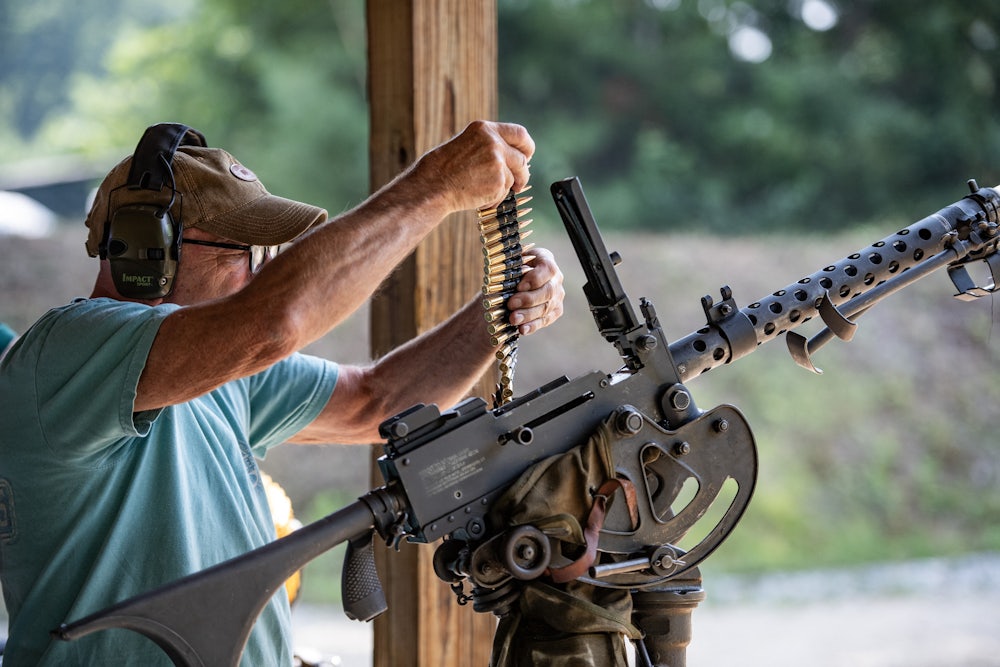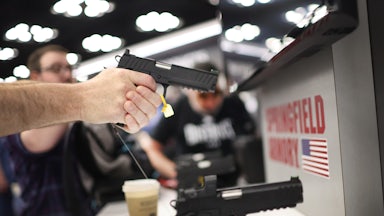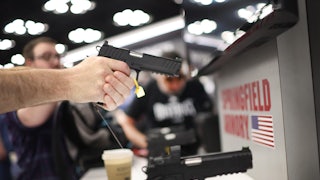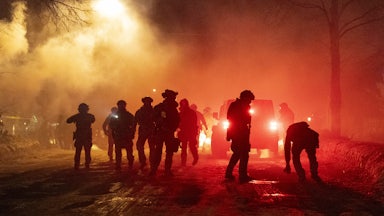According to the U.S. military’s Defense Advanced Research Projects Agency, better known as DARPA, anti-tank weaponry has come a long way. In the late 1990s, after a period of sustained research and development, the military procured bearable Javelin weapons, “the world’s first medium-range, one-man-portable, fire-and-forget anti-tank weapon system.” But the day may be coming when you will no longer have to enlist in the armed services to easily enjoy this firepower: An extreme new Second Amendment ruling apparently makes owning weapons like these the constitutional birthright of every American—rhetorically justified on the grounds that it merely implemented the Supreme Court’s guidance to review all gun laws using history and tradition, a framework announced in the justices’ 2022 decision in New York State Rifle & Pistol Association v. Bruen.
But history and tradition are unruly guides, and the court’s framework simply licenses lower courts to reach their own preferred outcomes on questions concerning gun rights. And already the once-formidable line between the ordinary firearms available to private citizens and cutting-edge military hardware is blurring.
Last week, in United States v. Morgan, a Kansas federal judge appointed by Donald Trump declared that the Second Amendment forbids the government from banning the possession of machine guns. This is a new frontier for the Second Amendment: Federal law has heavily regulated those weapons since 1934, soon after they first became commercially available, and has prohibited private ownership since 1986 (with an exception for those guns lawfully owned prior to that time). Despite this uninterrupted history of regulation, the Kansas federal court concluded that machine guns are “arms” within the Second Amendment’s protection because they are bearable weapons and that no historical tradition supported banning the mere possession of such lethal weapons.
The court’s conclusion is brazen and stunning. It credits an argument that other federal judges have recently and easily dismissed as “absurd” and “beyond outlandish.” Indeed, the Supreme Court itself cabined its watershed 2008 decision in District of Columbia v. Heller by underscoring that its ruling certainly did not mean machine guns would become freely available. As the court said, the historical tradition of regulating “dangerous and unusual weapons” meant that “weapons that are most useful in military service—M-16 rifles and the like—may be banned.”
The Morgan court was having none of it. Heller’s statement, the judge said, was not binding on lower courts because the Supreme Court had not confronted a machine gun ban in that case. So, he was free to ignore it. He also found that none of the historical regulations the government cited supported banning the possession of any bearable arms, as opposed to (at most) restricting how one carried them around publicly. Although the court did not mention the application of its ruling to cases like the bearable Javelin anti-tank weapons, it’s hard to see where the judge could draw the line if the principle of his decision were taken to its logical conclusion.
The Morgan ruling illuminates a central flaw in recent Second Amendment doctrine. The history and tradition framework announced in Bruen provides lower courts no guide. Judges are now free to read the historical record broadly or narrowly, draw strict or loose historical analogies, demand identical or just barely related historical precursors, and adopt high or low levels of generality when assessing the historical landscape of gun regulation—all within the confines of Bruen’s capaciously vacuous framework. In short, Bruen created a test that constrains judges not at all. It’s been wreaking havoc on gun laws nationwide.
Since Bruen, there has been a host of similar extreme and unprecedented decisions. One federal court ruled that the Second Amendment forbids a state from outlawing guns on playgrounds or in banks and hospitals. Others have said that individuals found to be a credible threat to their children or intimate partners cannot constitutionally be disarmed for even a temporary period. Still other courts have held that the Constitution dooms the federal law that prohibits individuals charged with felony offenses from acquiring new firearms, even when it remains legal for them to keep the guns they already possess.
These judicial rulings were novel, even though some of the laws they struck down have existed for decades. What’s remarkable is that in these cases, just as with the machine gun ruling in Morgan, no other courts had resolved challenges in those ways prior to Bruen. All such laws had been upheld or unchallenged, thought to be quite clearly constitutional.
This past summer, the Supreme Court firmly corrected one of these lower court errors. In United States v. Rahimi, the court chastised a lower federal court for invalidating the gun ban on those subject to domestic violence restraining orders. In a nearly unprecedented 8–1 decision on a contested constitutional question, the justices were adamant that this life-saving law was valid. Its prior cases, the justices insisted, “were not meant to suggest a law trapped in amber.” Indeed, “the Second Amendment permits more than just those regulations identical to ones that could be found in 1791.” Rather than search for identical laws in the past, “the appropriate analysis involves considering whether the challenged regulation is consistent with the principles that underpin our regulatory tradition.” The focus should be on the principles in the past, the Court insisted, not on whether the challenged law mirrored isolated historical statutes.
Morgan was having none of that either. In a decision that spans all of eight meager pages of substantive analysis, the court barely mentioned Rahimi at all. It certainly did not focus on “the principles” to which the historical record attests. Its analysis instead reads much more like that of the lower court ruling the Supreme Court reversed in Rahimi—rejecting potential comparisons in the historical record because they do not match the challenged law in all particulars.
It’s no great surprise that Morgan was decided by a judge appointed by the former president. Recent empirical research has demonstrated that the judges appointed by Donald Trump have been astonishingly friendly to all manner of Second Amendment claims. According to researchers who studied the data closely, these judges are almost twice as likely as even other Republican-appointed judges to vote in favor of a Second Amendment challenge. “The data suggest,” they write, “that Bruen had the greatest impact on the Trump appointees.”
Here’s the good news: Morgan is not likely to stand for long. The federal appeals court overseeing Kansas will probably reverse the decision and agree with every other court to review the issue that machine guns are not Second Amendment–protected firearms. But we can’t pretend that solves the problem. Bruen makes decisions like Morgan possible, in a way they simply were not previously. The Supreme Court’s history and tradition framework unjustifiably replaced the workable and conventional constitutional test that takes account of contemporary conditions, like the harms machine guns cause and how ill-suited they are to lawful self-defense.
In its stead may not quite be a law trapped in amber, but it is a law trapped in ambition. As the recent empirical research suggests, “gun rights cases present an opportunity for promotion-seeking judges to show their partisan chops to would-be appointers,” and Trump judges are most likely to “audition” with such pro-gun rulings. Those auditioning today may find themselves high on the Supreme Court short lists for future Republican presidential administrations. Until the Court is prepared to reverse course, we can expect increasingly extreme decisions that further dismantle this country’s already threadbare system of regulating the weapons that claim the lives of roughly 50,000 of our fellow citizens each year and the peace of so many countless others.










